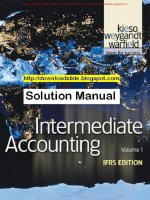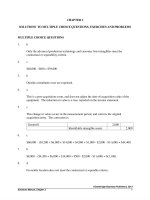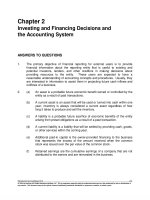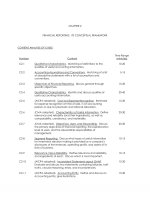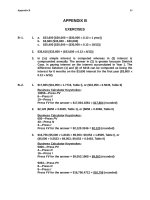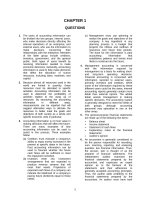Solution manual intermediate accounting 15e by stice ch02
Bạn đang xem bản rút gọn của tài liệu. Xem và tải ngay bản đầy đủ của tài liệu tại đây (258.42 KB, 46 trang )
CHAPTER 2
QUESTIONS
1. The accounting system generates a
variety of reports for use by various
decision makers. Among the most
common are general-purpose financial
statements, management reports, tax
returns, and other reports prepared for
government agencies such as the SEC.
analyzed in terms of their effects on
the various asset, liability, owners’
equity,
revenue,
and
expense
accounts of the business unit.
(3) Transactions are posted to the
appropriate accounts in the general
and subsidiary ledgers. The ledger
accounts classify and summarize the
full effect of all transactions recorded
in the journals and can be used in the
preparation of financial statements.
(4) A trial balance may be prepared
showing the account balances in the
general
ledger
and
reconciling
subsidiary ledger balances with
respective control account balances.
The trial balance provides a summary
of the information as classified and
summarized in the ledgers as well as
a verification of the accuracy of
recording and posting.
(5) Adjustments are made to bring the
accounts up to date. Adjustments are
necessary to record all accounting
information that has not yet been
recorded and to properly recognize all
revenues and expenses on an accrual
basis. If a work sheet is used (an
optional
step
in
the
cycle),
adjustments may be journalized and
posted any time prior to closing. If
statements are prepared directly from
ledger
balances,
however,
adjustments must be recorded at this
point.
(6) Financial statements are prepared.
Financial statements report the results
of operations and cash flows for a
period of time and show the financial
condition of the business unit as of a
certain date.
(7) Closing entries are journalized and
posted. Balances in nominal accounts
are closed into Retained Earnings.
Operating results as determined in the
summary
accounts
are
finally
transferred to Retained Earnings.
(8) A post-closing trial balance may be
prepared as an optional step in the
cycle. A post-closing trial balance is
2. A manual and an automated accounting
system are similar in that both are
designed to serve the same informationgathering and processing functions. Both
systems also use the same underlying
accounting concepts and principles. The
differences between a manual and an
automated accounting system involve
some
mechanical
aspects,
time
requirements, and the appearance of
records and reports. Due to advanced
technology and reduced prices, today
almost all successful businesses of any
size use computers to assist in the various
accounting functions.
3. The accounting process involves certain
procedures used by businesses to
produce financial statement data. The
recording phase of the accounting process
consists of those procedures used in the
continuing activity of analyzing, recording,
and classifying business transactions in
the various books of record (journals and
ledgers) during the fiscal period. The
reporting phase of the accounting process
consists of those procedures used at the
end of the fiscal period to update and
summarize data collected during the
recording phase. Financial statements are
prepared
from
the
updated
and
summarized data.
4. The accounting process includes the
following steps:
(1) Business documents are analyzed.
Business documents provide detailed
information
concerning
each
transaction and establish support for
the data recorded in the books of
original entry.
(2) Transactions
are
recorded
in
chronological order in books of original
entry—the journals. Transactions are
27
28
Chapter 2
prepared to check the equality of the
debits and credits after posting the
adjusting and closing entries.
The steps in the accounting process are
necessary to transform transaction data
into useful information as summarized in
the financial statements and other
accounting reports. Some steps are
optional, such as preparing a trial balance
and preparing a post-closing trial balance.
These steps help verify or facilitate the
accounting process but are not essential.
5. Under double-entry accounting, assets,
expenses, and dividends are increased by
debits and decreased by credits.
Liabilities, owners’ equity accounts, and
revenues are increased by credits and
decreased by debits.
6. a. Real accounts are balance sheet
accounts not closed to a zero balance
in the closing process. Nominal
accounts are income statement or
temporary owners’ equity accounts
closed out in the process of arriving at
the net increase or decrease in
owners’ equity for a period.
b. A general journal is the most flexible
book of original entry. It may be used
to record all business transactions or
simply those that cannot be recorded
in one of the special journals. Special
journals are designed to facilitate the
recording of some particular type of
frequently occurring transaction, such
as sales, purchases, cash receipts,
and cash disbursements.
c. The general ledger carries summaries
of all accounts appearing on the
financial
statements.
Subsidiary
ledgers afford additional detail in
support of certain general ledger
balances. Thus, accounts payable
appear in total in the general ledger,
but individual accounts with each
creditor are provided in the accounts
payable subsidiary ledger.
7. a. Adjusting entries are made at the end
of an accounting period to update
balance sheet accounts and to record
accrued expenses and accrued
revenues.
Frequently, adjusting entries are first
made on a work sheet and then are
recorded in the general journal from
which they are posted to the ledger
accounts.
b. Closing entries are made after the
adjusting entries have been posted.
They transfer all nominal account
balances to Retained Earnings.
8. The company accountant is disregarding
the periodic summary process and
jeopardizing the company’s audit trail by
not entering the adjusting entries in the
general journal. Adjusting entries are
made at the end of the period to bring
accounts up to date. These entries must
be entered first in the general journal and
then posted directly to the general ledger.
If the adjusting entries are not entered first
in the general journal, the journals will be
incomplete and will not provide the
support necessary for an adequate
accounting system.
9. Examples of contra accounts include
Allowance for Bad Debts, Accumulated
Depreciation,
Discount
on
Notes
Receivable, Discount on Notes Payable,
and Discount on Bonds Payable. Contra
accounts are subtracted from related
accounts. Hence, they are sometimes
referred to as offset accounts. Contra
accounts are used to adjust accounts
when the original balance needs to be
preserved.
For
example,
adequate
disclosure in financial reports requires
disclosure of both the original cost and the
depreciated cost of assets. A contra
account, Accumulated Depreciation, is
used for this purpose.
10. Both methods, if properly applied, result in
the same account balances. The entries
that would be required on December 31
for (a) and (b), assuming that $400 was
paid for insurance for one year beginning
April 1, are as follows:
a. Original entry:
Insurance Expense...... 400
Cash..........................
400
Adjusting entry:
Prepaid Insurance....... 100
Insurance Expense. .
b. Original entry:
Prepaid Insurance....... 400
Cash..........................
Adjusting entry:
Insurance Expense...... 300
Prepaid Insurance....
11. A merchandising enterprise using a
periodic (physical) inventory system does
not maintain book inventory records and
thus must take a physical inventory at the
end of the accounting period to determine
the proper inventory to be reported on the
balance sheet and the cost of goods sold
to be reported on the income statement.
The adjusting entry can be made by first
debiting or crediting inventory to bring the
beginning balance up to date (i.e., to the
amount on hand as determined by the
physical count of inventory). The
purchases account is also credited, and
any related accounts are closed to Cost of
Goods Sold. The balancing debit amount
is the Cost of Goods Sold for the period.
A merchandising enterprise using a
perpetual inventory system maintains the
inventory and cost of goods sold accounts
directly in the ledger, and thus no
adjustment is necessary. However, it is
recommended that a physical inventory be
taken periodically to verify the perpetual
records and that the records be adjusted
to the physical count through a debit or
credit to Cost of Goods Sold.
12. A work sheet is a multicolumn form
designed to facilitate the summarization
and organization of accounting data
needed
to
prepare
the
financial
statements. The number of columns and
the headings used may vary, depending
on the needs of a particular business.
While the work sheet is an optional step in
the accounting process, it is a valuable aid
in completing the trial balance and
adjustment procedures.
13. When a work sheet is used as a basis for
statement preparation, the adjustments
can be formally recorded in the journals
and posted to the ledger accounts at any
time prior to closing the books. However, if
a work sheet is not used, financial
statements must be prepared directly from
the accounts; thus, the adjustments must
be recorded and posted prior to statement
preparation.
100
400
14. a. The procedure is acceptable. It gives
the same results as the standard
closing procedures. The bookkeeper
for Miller Hardware Store simply
closes all nominal accounts using a
compound entry instead of making
300
29
30
Chapter 2
numerous entries to obtain the same
result.
b. An alternative closing procedure is to
summarize all revenue and expense
items together with the change in
inventory
position
ultimately
transferred to Retained Earnings.
15. Only the following accounts would be
closed, generally with the following
debit/credit entries:
Rent Expense..................
Credit
Depreciation Expense....
Credit
Sales................................
Debit
Sales Discounts..............
Credit
Purchases........................
Credit
Freight-In.........................
Credit
Interest Revenue.............
Debit
Advertising Expense.......
Credit
Purchase Discounts........
Debit
Dividends.........................
Credit
16. Accrual accounting recognizes revenues
and expenses when they are earned and
incurred, not necessarily when cash is
received or paid. Cash-basis accounting
recognizes revenues and expenses as
cash is received or disbursed, regardless
of the earnings process or the matching
concept. Generally accepted accounting
principles require the use of accrual
accounting.
17. The
use
of
double-entry
accrual
accounting is more accurate than a cashbasis
accounting
system
primarily
because
(a) The likelihood of errors and omissions
is greatly increased in the absence of
double-entry analysis and a trial
balance to test the accuracy of the
analysis and recording process.
(b) Recording events under an accrual
system as they occur more accurately
reflects the effects and timing of an
event than does a system that records
the events when cash is received or
paid, regardless of the earnings
process and the matching concept.
18. The major advantages offered by
computers as compared with manual
processing of accounting data are as
follows:
(a) Computers process large amounts of
accounting data at great speeds, thus
providing information for decision
(b)
(c)
(d)
(e)
making on a more timely basis than a
manual system would.
Computers
process
information
accurately with less chance of human
error than a manual processing
system.
Computers require computer-oriented
business papers and accounting
records
that
promote
clerical
organization and efficiency.
Computers usually require a general
centralization
of
all
accounting
activities and thus increase the
efficiency and cost-effectiveness of the
accounting system.
Computers can process accounting
data and transmit such data in direct
correspondence with customers and
creditors in the form of billings,
invoices, checks, and so on.
19. The function of the computer is limited to
arithmetical and clerical functions. It can
follow instructions that are provided on a
programmed step-by-step basis, but unlike
a human, it cannot think for itself. While it
can serve effectively in recording activities,
it cannot replace the accountant, who
must still determine what principles are
applicable in arriving
at financial
statements that present fairly the
company’s financial position and results of
operations.
31
PRACTICE EXERCISES
PRACTICE 21
Cash
Accounts Receivable
Sales
3,000
9,000
Cost of Goods Sold
Inventory
7,500
12,000
7,500
PRACTICE 22
Equipment
Cash
Short-Term Notes Payable
Long-Term Notes Payable
100,000
10,000
20,000
70,000
PRACTICE 23
Cash
Equipment
Gain on Sale of Land
Land
40,000
75,000
65,000
50,000
PRACTICE 24
Dividends (or Retained Earnings)
Cash
12,000
12,000
PRACTICE 25
Wages Expense
Land
30,000
30,000
PRACTICE 26
Cash
Beginning balance
a.
d.
Ending balance
10,000
2,775
3,450
8,525
1,500
6,200
b.
c.
PRACTICE 27
Accounts Payable
b.
c.
6,500
200
8,000
2,700
2,550
Beginning Balance
a.
d.
6,550
Ending Balance
PRACTICE 28
Cash
Inventory
Accounts Payable
Paid-In Capital
Retained Earnings (beginning)
Sales
Cost of Goods Sold
Dividends
Total
$
Debit
400
4,000
Credit
$ 1,100
2,000
1,000
10,000
9,000
700
______
$14,100
$14,100
Debit
$ 800
3,000
Credit
PRACTICE 29
Cash
Prepaid Rent Expense
Unearned Service Revenue
Paid-In Capital
Retained Earnings (beginning)
Service Revenue
Salary Expense
Rent Expense
Total
$ 4,700
2,000
1,500
20,000
18,000
6,400
______
$28,200
$28,200
PRACTICE 210
From Practice 28:
Sales
Cost of Goods Sold
Net Income
From Practice 29:
Service Revenue
Salary Expense
Rent Expense
Net Loss
$10,000
9,000
$ 1,000
$20,000
$18,000
6,400
24,400
$ (4,400)
PRACTICE 211
From Practice 28:
Assets
Cash
Inventory
Total Assets
$ 400
4,000
$4,400
Liabilities
Accounts Payable
$1,100
Stockholders’ Equity
Paid-In Capital
Retained Earnings (ending)
$2,000
1,300
Total Liabilities and Stockholders’ Equity
$4,400
Computation of ending Retained Earnings:
$1,000 + ($10,000 – $9,000) – $700 = $1,300
From Practice 29:
Assets
Cash
Prepaid Rent Expense
Total Assets
$ 800
3,000
$3,800
Liabilities
Unearned Service Revenue
$ 4,700
Stockholders’ Equity
Paid-In Capital
Retained Earnings (ending)
Total Liabilities and Stockholders’ Equity
Computation of ending Retained Earnings:
$1,500 + ($20,000 – $18,000 – $6,400) = $(2,900)
$ 2,000
(2,900)
$ 3,800
PRACTICE 212
Depreciation Expense
Accumulated Depreciation
5,500
5,500
PRACTICE 213
Bad Debt Expense
Allowance for Bad Debts
1,200
1,200
PRACTICE 214
Interest Expense
Interest Payable
693
693
$8,000 0.13 8/12 = $693
PRACTICE 215
Rent Expense
Prepaid Rent
1,500
1,500
$3,600/12 = $300 per month; amount used = $300 5 months = $1,500
PRACTICE 216
Unearned Service Revenue
Service Revenue
4,400
4,400
$4,800/12 = $400 per month; amount earned = $400 11 months = $4,400
PRACTICE 217
Sales
Retained Earnings
Retained Earnings
Cost of Goods Sold
Retained Earnings
Dividends
Balance sheet accounts are not closed.
10,000
10,000
9,000
9,000
700
700
PRACTICE 218
Service Revenue
Retained Earnings
20,000
Retained Earnings
Salary Expense
Rent Expense
24,400
Balance sheet accounts are not closed.
20,000
18,000
6,400
EXERCISES
2–19.
1. and 2.
Cash
Bal. 200,000 (15) 18,000
(7)
14,700 (18) 10,400
(27) 150,000
Bal. 36,300
Accounts Receivable
Bal. 21,540 (7) 15,000
(1)
15,000
Bal. 21,540
Inventory
Bal. 32,680 (1)
(5)
8,350
Bal. 33,580
Land
Bal. 15,400
(27) 120,000*
Bal. 135,400
Building
Bal.
9,000
(27) 280,000*
Bal. 289,000
Machinery
(18) 10,400
Bal. 10,400
7,450
*($150,000/$500,000 $400,000) *($350,000/$500,000 $400,000)
Accounts Payable
Bal.
9,190
(5)
8,350
Bal. 17,540
Common Stock
Bal. 185,000
Sales
(1)
Bal.
Dividends Payable
(22) 33,750
Bal. 33,750
Mortgage Payable
Bal. 23,700
(27) 250,000
Bal. 273,700
Retained Earnings
Cost of Goods Sold
Bal. 60,730 (1)
7,450
Bal. 7,450
Sales Discounts
15,000 (7)
300
15,000 Bal.
300
Dividends
(22) 33,750*
Bal. 33,750
*($0.75 45,000)
Wages Expense
(15) 18,000
Bal. 18,000
2–19.
(Concluded)
3.
Alaska Supply Corporation
Trial Balance
October 31, 2005
Debit
Cash.................................................
$ 36,300
Accounts Receivable......................
21,540
Inventory..........................................
33,580
Land.................................................
135,400
Building............................................
289,000
Machinery........................................
10,400
Accounts Payable...........................
Dividends Payable..........................
Mortgage Payable...........................
Sales.................................................
Sales Discounts..............................
300
Cost of Goods Sold........................
7,450
Wages Expense...............................
18,000
Common Stock...............................
Retained Earnings..........................
Dividends.........................................
33,750
Totals..........................................
$ 585,720
2–20.
1.
Credit
$ 17,540
33,750
273,700
15,000
185,000
60,730
$585,720
Adjusting Entries
(a) Insurance Expense.....................................................
Prepaid Insurance..................................................
($4,800 ÷ 24 mo. = $200 6 mo. = $1,200)
1,200
(b) Rent Revenue..............................................................
Unearned Rent Revenue.......................................
($5,750 ÷ 5 mo. = $1,150 1 mo. = $1,150)
1,150
(c) Advertising Materials.................................................
Advertising Expense.............................................
475
(d) Prepaid Rent................................................................
Rent Expense.........................................................
($3,000 ÷ 5 mo. = $600 3 mo. = $1,800)
1,800
(e) Office Supplies............................................................
Miscellaneous Office Expense.............................
250
(f)
428
Interest Expense.........................................................
Interest Payable.....................................................
1,200
1,150
475
1,800
250
428
2–20.
(Concluded)
2.
Sources of Information
(a) The insurance register; the insurance policy
(b) The journal entry or other original data from which the posting was
made to the rental revenue account; the rental contract
(c) The physical count of advertising materials on hand
(d) The cash disbursements journal or vouchers payable record; the
rental contract
(e) The physical count of supplies on hand
(f) The notes payable register; the note itself
2–21.
Adjusting and Correcting Entries on December 31, 2005
(a) Allowance for Bad Debts............................................
Accounts Receivable—Clarke Realty..................
380
(b) Loss on Damages from Breach of Contract.............
Lawsuit Payable—E. J. Stanley Co.......................
2,200
(c) Receivable from Insurance Company.......................
Accumulated Depreciation—Furniture
and Fixtures................................................................
Loss from Fire.............................................................
Furniture and Fixtures...........................................
6,500
380
2,200
2,400
1,300
10,200
(d) Advances to Salespersons........................................
Sales Salaries Expense.........................................
1,150
(e) Repairs Expense.........................................................
Machinery...............................................................
Depreciation Expense—Machinery...........................
Accumulated Depreciation—Machinery..............
*
800
*Depreciation: ($18,460 – $4,460) 0.10 = $1,400
($4,460 – $800) 0.05 =
183
$ 1,583
1,150
800
1,583 *
1,583
2–22.
2–23.
1. Insurance Expense.............................................................
Prepaid Insurance.........................................................
($5,600 + $2,500 – $6,400 = $1,700)
1,700
2. Depreciation Expense........................................................
Accumulated Depreciation...........................................
[$85,200 – ($7,500 – $1,600) – $88,700 = $9,400]
9,400
3. Unearned Rent....................................................................
Rent Revenue................................................................
($11,000 + $9,000 – $15,000 = $5,000)
5,000
4. Salaries Payable..................................................................
Salaries Expense...........................................................
($42,860 – $34,760 = $8,100)
8,100
1.
1,700
9,400
5,000
8,100
Adjusting Entries
Inventory ............................................................................. 50,000
Cost of Goods Sold............................................................ 230,000
Purchases......................................................................
280,000
Prepaid Operating Expenses.............................................
General Operating Expenses.......................................
4,000
Sales Commissions............................................................
Sales Commissions Payable........................................
5,900
Investment Revenue Receivable.......................................
Investment Revenue.....................................................
1,000
General Operating Expenses.............................................
Accumulated Depreciation—Buildings.......................
4,500
General Operating Expenses.............................................
Accumulated Depreciation—Machinery.....................
5,000
Income Tax Expense..........................................................
Income Taxes Payable..................................................
18,100
4,000
5,900
1,000
4,500
5,000
18,100
Closing Entries
Sales.................................................................................... 590,000
Investment Revenue..........................................................
6,000
Retained Earnings.........................................................
596,000
Retained Earnings.............................................................. 560,500
General Operating Expenses.......................................
106,500
Sales Commissions......................................................
205,900
Cost of Goods Sold......................................................
230,000
Income Tax Expense.....................................................
18,100
2–23.
(Concluded)
2.
Pioneer Heating Corporation
Post-Closing Trial Balance
Cash...........................................................................
Investments...............................................................
Investment Revenue Receivable.............................
Inventory....................................................................
Prepaid Operating Expenses...................................
Land...........................................................................
Buildings....................................................................
Accumulated Depreciation—Buildings...................
Machinery..................................................................
Accumulated Depreciation—Machinery.................
Accounts Payable.....................................................
Income Taxes Payable..............................................
Sales Commissions Payable...................................
Common Stock.........................................................
Additional Paid-In Capital.........................................
Retained Earnings....................................................
Totals....................................................................
494,000
Debit
$ 39,000
50,000
1,000
50,000
4,000
70,000
180,000
Credit
$
4,500
100,000
$494,000
5,000
65,000
18,100
5,900
320,000
40,000
35,500
$
2–24.
1.
Adjusting Entries
(a) No adjustment necessary.
(b) Selling, General, and Administrative Expenses.......
Prepaid Expenses..................................................
6,000
(c) Unearned Revenue.....................................................
Rent Revenue.........................................................
24,750
(d) Selling, General, and Administrative Expenses.......
Plant and Equipment.............................................
10,000
(e) Selling, General, and Administrative Expenses.......
Other Assets...........................................................
1,500
(f)
6,000
24,750
10,000
1,500
Other Assets...............................................................
Selling, General, and Administrative Expenses. .
15,000
(g) Accounts Payable.......................................................
Inventory.................................................................
6,000
15,000
6,000
2–24.
(Concluded)
2.
Closing Entries
Sales............................................................................. 2,801,000
Interest Revenue..........................................................
23,000
Rent Revenue...............................................................
24,750
Retained Earnings..................................................
2,848,750
Retained Earnings....................................................... 2,550,500
Cost of Goods Sold...............................................
1,565,000
Selling, General, and Administrative Expenses. .
642,500
Interest Expense....................................................
79,000
Income Tax Expense*............................................
264,000
Retained Earnings.......................................................
Dividends................................................................
139,000
139,000
*Assume that the adjustments do not affect Income Tax Expense.
3.
Feigenbaum Company
Post-Closing Trial Balance
December 31, 20XX
Cash...........................................................................
Accounts Receivable................................................
Inventory....................................................................
Prepaid Expenses.....................................................
Land...........................................................................
Plant and Equipment................................................
Other Assets.............................................................
Accounts Payable.....................................................
Wages, Interest, and Taxes Payable........................
Unearned Revenue...................................................
Long-Term Debt........................................................
Other Liabilities.........................................................
Common Stock.........................................................
Retained Earnings....................................................
Totals....................................................................
Debit
$ 58,000
402,000
51,000
48,000
65,000
1,157,000
1,576,500
$ 3,357,500
Credit
$ 141,000
215,000
8,250
1,201,000
336,000
185,000
1,271,250
$ 3,357,500
2–25.
1. Received $300 cash as payment on customer accounts.
2. Recorded return of inventory purchased on account for $400 using the
perpetual method.
3. Borrowed $5,000 cash.
4. Sold inventory costing $550 for $200 cash and $700 on account.
5. Paid $200 cash for prepaid insurance policy.
2–25.
(Concluded)
6. Declared dividends of $250.
7. Closed Dividends to Retained Earnings at the end of the period.
Dividends for the period totaled $1,000.
8. Used up $50 worth of the prepaid insurance policy.
9. Purchased inventory for $150 cash and $450 on account.
10. Wrote off a bad debt of $46.
11. Recorded accrued interest payable of $125.
12. Paid wages of $205—$75 related to wages for the current period and
$130 was for wages for the prior period.
13. Paid account totaling $500. Because the payment was made within the
discount period, a $10 purchase discount was taken.
2–26.
Adjusting Entries
(a)
Depreciation Expense.....................................................
Accumulated Depreciation—Equipment..................
($46,000 – $1,000 = $45,000; $45,000/9 =
$5,000/year)
5,000
5,000
(b)
Inventory...........................................................................
8,000
Cost of Goods Sold......................................................... 112,000
Purchases...................................................................
120,000
To adjust the inventory to its ending balance.
(c)
Prepaid Selling Expense.................................................
Selling Expense..........................................................
2,500
Interest Receivable..........................................................
Interest Revenue........................................................
750
Advertising Expense.......................................................
Selling Expense..........................................................
620
(d)
(e)
2,500
750
620
2–27.
Adjusting Entries
(a)
Insurance Expense..........................................................
Prepaid Insurance......................................................
*A, $3,600 21/24...................................
B, $1,800 2/6........................................
C, $12,000 27/36..................................
Prepaid amount.....................................
Account balance...................................
Adjustment............................................
$ 3,150
600
9,000
$ 12,750
14,100
$ (1,350)
1,350 *
1,350
2–27.
(Concluded)
(b)
Subscription Revenue.....................................................
Unearned Subscription Revenue..............................
†July, $27,000 3/12...............................
October, $22,200 6/12.........................
January, $28,800 9/12.........................
April, $20,700 12/12............................
Unearned amount..................................
Account balance...................................
Adjustment............................................
(c)
(d)
(e)
3,900†
3,900
$ 6,750
11,100
21,600
20,700
$ 60,150
56,250
$ 3,900
Interest Payable...............................................................
Interest Expense........................................................
[$825 – ($45,000 0.10 1/12)]
450
Supplies Expense............................................................
Supplies......................................................................
($2,190 – $1,410)
780
Salaries Payable...............................................................
Salaries Expense........................................................
[$9,750 – ($11,250 2/5)]
5,250
450
780
5,250
2–28.
1.
Adjusting Entries
Rent Expense......................................................................
Prepaid Rent..................................................................
12,600
Salaries and Wages Expense.............................................
Salaries and Wages Payable........................................
2,600
12,600
2,600
Unearned Consulting Fees................................................ 118,000
Consulting Fees Revenue............................................
118,000
Interest Receivable.............................................................
Interest Revenue...........................................................
1,150
2. Rent Expense = $6,200 + $10,000 – $3,600 = $12,600
Salaries and Wages Expense = $50,000 – $1,900 + $4,500 = $52,600
Consulting Fees Revenue = $16,400 + $108,000 – $6,400 = $118,000
Interest Revenue = $2,400 – $650 + $1,800 = $3,550
1,150
2–29.
1.
Balance
Carried
Forward
Account
(a)
(b)
(c)
(d)
(e)
(f)
(g)
(h)
(i)
(j)
(k)
(l)
(m)
(n)
(o)
(p)
(q)
(r)
(s)
2.
Cash..........................................
Sales.........................................
Dividends..................................
Inventory..................................
Selling Expenses.....................
Capital Stock............................
Wages Expense.......................
Dividends Payable...................
Cost of Goods Sold.................
Accounts Payable....................
Accounts Receivable..............
Prepaid Insurance....................
Interest Receivable..................
Sales Discounts.......................
Interest Revenue.....................
Supplies....................................
Retained Earnings...................
Accumulated Depreciation.....
Depreciation Expense.............
Balance
Closed by
Debiting
Balance
Closed by
Crediting
X
X
X
X
X
X
X
X
X
X
X
X
X
X
X
X
X
X
X
Closing Entries
Sales....................................................................................
Interest Revenue.................................................................
Retained Earnings.........................................................
75,000
6,500
Retained Earnings..............................................................
Selling Expenses...........................................................
Wages Expense.............................................................
Cost of Goods Sold......................................................
Sales Discounts............................................................
Depreciation Expense...................................................
54,800
Retained Earnings..............................................................
Dividends.......................................................................
3,500
3. $26,700 net income ($81,500 – $54,800 = $26,700)
81,500
7,900
14,400
26,500
4,200
1,800
3,500
2–30.
Closing Entries
Revenues..................................................................... 196,400
Retained Earnings..................................................
196,400
Retained Earnings......................................................
Expenses................................................................
80,200
Retained Earnings......................................................
Dividends................................................................
32,500
80,200
32,500
2–31.
Changes in Account Balances
Debit
Cash...........................................................................
Accounts receivable.................................................
Inventory....................................................................
Equipment.................................................................
Accounts payable.....................................................
Loans payable...........................................................
Interest payable.........................................................
Contributed capital ($40,000 + $20,000).................
Retained earnings (or Dividends)............................
Credit
$ 21,000
25,000
$ 10,000
70,000
5,000
50,000
1,000
60,000
15,000
$136,000
121,000
$
Increase in net assets or net income......................
15,000
$136,000
136,000
$
2–32.
Impact of error correction on net income
2003
Accrued salaries:
2003 error...................................
2004 error...................................
2005 error....................................
Interest receivable:
2003 error...................................
2004 error...................................
2005 error....................................
Net income increase (decrease).....
$(25,000)
10,500
$ (14,500)
2004
2005
$ 25,000
(19,000) $ 19,000
(32,000)
(10,500)
8,500
$ 4,000
(8,500)
13,200
$ (8,300)
PROBLEMS
2–33.
1. May 1
3
4
4
5
8
9
9
10
12
15
18
19
22
23
25
29
2–33.
(Concluded)
Cash..................................................................... 40,000
Capital Stock..................................................
40,000
Inventory..............................................................
8,000
Accounts Payable..........................................
8,000
Office Supplies....................................................
500
Cash................................................................
500
No entry.
Accounts Receivable.......................................... 14,000
Sales...............................................................
14,000
Cost of Goods Sold............................................
7,500
Inventory........................................................
7,500
Wages Expense...................................................
2,450
Cash................................................................
2,000
Employee Income Taxes Payable................
450
No entry.
Advertising Expense...........................................
1,500
Cash................................................................
1,500
Cash..................................................................... 13,580
Sales Discounts..................................................
420
Accounts Receivable....................................
14,000
Machinery.............................................................
6,400
Cash................................................................
6,400
Dividends............................................................. 25,000
Dividends Payable.........................................
25,000
Accounts Receivable.......................................... 21,000
Cash.....................................................................
3,000
Sales...............................................................
24,000
Cost of Goods Sold............................................ 13,000
Inventory........................................................
13,000
Accounts Payable...............................................
8,000
Cash................................................................
8,000
No entry.
No entry.
Building................................................................ 150,000
Cash................................................................
15,000
Mortgage Payable..........................................
135,000
Dividends Payable............................................... 25,000
Cash................................................................
25,000
2. The single most important event was the free, favorable publicity in the
national newsmagazine on May 22, which undoubtedly led to the large
increase in market value the following day. However, since no
transaction occurred (i.e., there was no exchange of goods or services),
no journal entry was made. Because the accounting records include
only transactions, some economically relevant events are not recorded.
2–34.
(a)
(b)
(c)
(d)
(e)
(f)
(g)
(h)
(i)
(j)
(k)
(l)
(m)
(n)
(o)
(p)
(q)
(r)
(s)
Account Title
(1)
(2)
(3)
(4)
(5)
B/S
Real
Closed Debit (Dr.)
I/S A, L, OE,
or
or
or
N
R, E, O Nominal Open Credit (Cr.)
Unearned Rent Revenue
Accounts Receivable
Inventory
Accounts Payable
Prepaid Rent
Mortgage Payable
Sales
Cost of Goods Sold
Dividends
Dividends Payable
Interest Receivable
Wages Expense
Interest Revenue
Supplies
Accumulated Depreciation
Retained Earnings
Discount on Bonds Payable
Goodwill
Additional Paid-In Capital
B/S
B/S
B/S
B/S
B/S
B/S
I/S
I/S
N
B/S
B/S
I/S
I/S
B/S
B/S
B/S
B/S
B/S
B/S
*Contra.
L
A
A
L
A
L
R
E
O
L
A
E
R
A
A*
OE
L*
A
OE
Real
Real
Real
Real
Real
Real
Nominal
Nominal
Nominal
Real
Real
Nominal
Nominal
Real
Real
Real
Real
Real
Real
Open
Open
Open
Open
Open
Open
Closed
Closed
Closed
Open
Open
Closed
Closed
Open
Open
Open
Open
Open
Open
Cr.
Dr.
Dr.
Cr.
Dr.
Cr.
Cr.
Dr.
Dr.
Cr.
Dr.
Dr.
Cr.
Dr.
Cr.
Cr.
Dr.
Dr.
Cr.
2–35.
1. Adjusting Entries on 12/31/05:
(a) Accounts Payable.......................................................
Cash........................................................................
2,900
(b) Depreciation Expense................................................
Accumulated Depreciation—Building..................
($120,000 1/20 = $6,000)
6,000
(c) Bad Debt Expense......................................................
Allowance for Bad Debts.......................................
[$460 + (0.025 $34,000) = $1,310]
1,310
(d) Interest Receivable.....................................................
Interest Revenue....................................................
($40,000 0.12 5/12 = $2,000)
2,000
(e) Sales Revenue............................................................
Unearned Sales Revenue......................................
($8,500 0.80 = $6,800)
6,800
(f)
Discount on Notes Payable.......................................
Interest Expense....................................................
($600 30/60 = $300)
2,900
6,000
1,310
2,000
6,800
300
300
2. Net Change in Income:
Add:
Interest revenue not recorded......................
Overstatement of interest expense.............
Deduct: Depreciation expense...................................
Bad debt expense..........................................
Overstatement of sales revenue..................
Net reduction in reported net income..........................
(11,810)
$2,000
300
$6,000
1,310
6,800
$ 2,300
(14,110)
$
2–36.
(a) 2005
Oct. 1
Rent Expense......................................................
Cash................................................................
($1,800 ÷ 9/12 = $2,400 annual expense)
2,400
Advertising Expense...........................................
Cash................................................................
($1,700 ÷ 5/12 = $4,080 annual expense)
4,080
Cash.....................................................................
Rent Revenue................................................
($900 ÷ 2/12 = $5,400 annual revenue)
5,400
Office Supplies Expense....................................
Cash................................................................
($1,000 ÷ 6/12 = $2,000 annual expense)
2,000
Insurance Expense..............................................
Cash................................................................
($1,050 ÷ 7/12 = $1,800 annual expense)
1,800
(a) Bad Debt Expense..............................................................
Allowance for Bad Debts..............................................
(b) Interest Revenue.................................................................
Interest Receivable.......................................................
(c) Discount on Notes Payable...............................................
Interest Expense...........................................................
(d) No adjustment required.
(e) Salaries and Wages Expense.............................................
Salaries and Wages Payable........................................
(f) Discount on Notes Receivable..........................................
Interest Revenue...........................................................
(g) Unearned Rent Revenue....................................................
Rent Revenue................................................................
5,080
(b) June 1
(c) Mar. 1
(d) July 1
(e) Aug. 1
2,400
4,080
5,400
2,000
1,800
2–37.
5,080
600
600
1,100
1,100
2,200
2,200
900
900
1,700
1,700
COMPUTATIONS:
(a) Estimated uncollectibles: 0.04 $152,000 = $6,080
Required increase in allowance account balance: $6,080 – $1,000 = $5,080
(b) Required reduction in accrued interest on investments balance:
$2,800 – $2,200 = $600
(c) Required increase in discount on notes payable balance: $1,400 – $300 = $1,100
(d) Required increase in accrued salaries and wages balance: $6,200 – $4,000 = $2,200
(e) Required reduction in discount on notes receivable balance: $2,800 – $1,900 =
$900
(f) Required reduction in unearned rent revenue balance: $1,700 – 0 = $1,700
2–38.
1.
(a) Accounts Receivable.........................................................
Bad Debt Expense..............................................................
Sales .............................................................................
Allowance for Bad Debts..............................................
28,000
3,000
(b) Salaries Expense................................................................
Salaries Payable............................................................
11,000
(c) Prepaid Rent........................................................................
Rent Expense................................................................
9,000
(d) Utilities Expense.................................................................
Accrued Liabilities (or Utilities Payable).....................
2,700
(e) Depreciation Expense........................................................
Accumulated Depreciation—Equipment.....................
($30,000/5 years)
6,000
(f) Commission Expense........................................................
Commission Payable....................................................
($25,000 0.15. No commission on uncollectible
accounts)
3,750
(g) Prepaid Insurance...............................................................
Insurance Expense.......................................................
($6,000 6/12)
3,000
(h) Interest Expense.................................................................
Interest Payable.............................................................
($50,000 0.12 2/12)
1,000
(i) Income Tax Expense..........................................................
Income Taxes Payable..................................................
[$65,750 0.40; see (2).]
26,300
28,000
3,000
11,000
9,000
2,700
6,000
3,750
3,000
1,000
26,300
